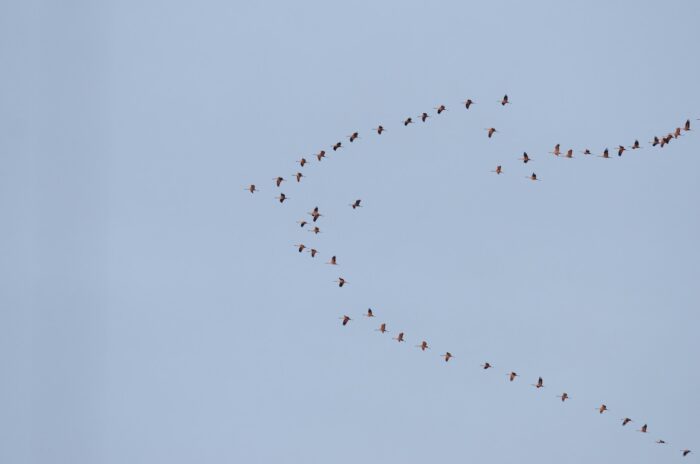
Wildlife migration patterns have a large influence on our global ecology, playing a major role in preserving the delicate balance of ecosystems worldwide.
From the seasonal flights of migrating birds, to the yearly voyage of whales across the ocean, or the great passage of wildebeest across the African plains, they all present fascinating and complex sequences of movement that have been studied, admired and puzzled over for centuries.
These movements, often dictated by changes in the season, availability of food, and mating rituals, allow species to survive or flourish, playing a key role in biological diversity.
The advent of technology has changed the way we understand and track these wildlife migrations. Traditional methods such as physically tagging animals or simple observation have their limitations.
Now, with technological advancements, scientists have the ability to monitor and collect data about species movements like never before. Usage of satellite telemetry, GPS tracking, drones, and increasingly, artificial intelligence, allows us to gather accurate, real-time data about the movements of animal populations.
This not only enriches our understanding of animal behavior, but also helps us in making decisions related to conservation. Technology, thus, has become a game changer in wildlife migration tracking, marking a significant transformation in how we study and interact with nature.
Wildlife Migration Patterns

Wildlife migration refers to the seasonal movement of animal species from one habitat to another in search of food, for mating, or to escape harsh weather conditions. This often involves long-distance travel, crossing numerous geographical barriers, with impeccable timing and route-finding skills.
In many situations, these migration routes are preserved in the genomes of species, instinctually guiding generations across the globe. Advanced technology tools, including wildlife management software, can assist in monitoring these routes by collecting, analyzing and visualizing movement data in a more efficient manner than traditional efforts.
Wildlife migration patterns impact ecosystems and affect biodiversity. On the ecosystem level, animal migrations contribute largely to nutrient cycling, prey-predator dynamics, and population distributions. For instance, when migrating animals travel, they distribute resources around the globe, affecting the health, composition, and dynamics of the ecosystems they cross.
As for biodiversity, the study of migration patterns provides insights into the evolutionary adaptation of species to changes in their environment, and how these adaptations contribute to genetic diversity. Thereby, understanding these patterns enriches wildlife management strategies, enabling the protection of threatened species and the preservation of the global ecosystem balance.
Modern Tools in Tracking Wildlife Migration
GPS and Satellite Telemetry
GPS and satellite telemetry are modern tools extensively used in wildlife tracking. These tools involve attaching transmitters or tags to animals, which then send signals to GPS satellites. The satellites, in turn, calculate the animal’s precise geographical location and transmit the data back to the researchers.
Notably, the Argos system, an international program for collecting and disseminating environmental data from tagged animals, has provided valuable migration information for several species. For instance, it has helped in the Pacific Black Brant, a sea bird’s migration study which revealed their nonstop, 5000km, 60 to 72 hour journey from Alaska to Mexico.
Radio Tracking
This method entails fitting the animal with a small radio transmitter. The signals emanating from the transmitter are picked up by a handheld antenna or through an automated network of radio receivers. This provides the location of the animal to be tracked over time. By applying this technique, researchers from the British Trust of Ornithology were able to trail the migration patterns of cuckoos, unveiling their perilous route through the Sahara Desert.
Drones and Automated Recognition
Drones equipped with high-definition cameras and automated recognition software can monitor and track wildlife from the sky. This approach enables researchers to cover vast areas in a relatively shorter time and can be less invasive than traditional techniques. Scientists from Liverpool John Moores University, UK, used thermal imaging drones to spot and identify endangered primates in forest canopies during a study in Africa.
Impact of Modern Technology on Wildlife Conservation

First and foremost, modern technology has significantly improved our ability to monitor and study wildlife in their natural habitats without causing significant disruption. Using remote sensing technologies such as GPS, drones, or camera traps, scientists can observe elusive or endangered species and gain insights into their behavior, habitat usage, and population dynamics.
This data is used for identifying threats, understanding their impacts, and devising effective strategies to mitigate them. Technology also aids in implementing and enforcing protective measures. For instance, SMART (Spatial Monitoring and Reporting Tool) technology is being used globally to improve the effectiveness of wildlife law enforcement patrols, resulting in better protection for wildlife in protected areas.
Real-time tracking and monitoring technologies provide valuable data that can inform management decisions, allowing for more proactive and adaptive management approaches. This can include determining the sustainable number of animals that can be hunted, making informed decisions about habitat preservation, and understanding the impacts of climate change or introduced species on animal populations.
Predictive modeling tools can simulate the future impacts of different management strategies, helping to assure the long-term viability of wildlife populations.
Rapid advancements in technology have enhanced our understanding of wildlife migration patterns, proving to be instrumental in wildlife conservation efforts. By providing increased precision, real-time tracking, and a wealth of data, these technologies offer valuable insights which aid in the sustainable management of wildlife populations.
As technology continues to improve, its role is set to become even more central to the study, understanding, and protection of our planet’s diverse wildlife.














